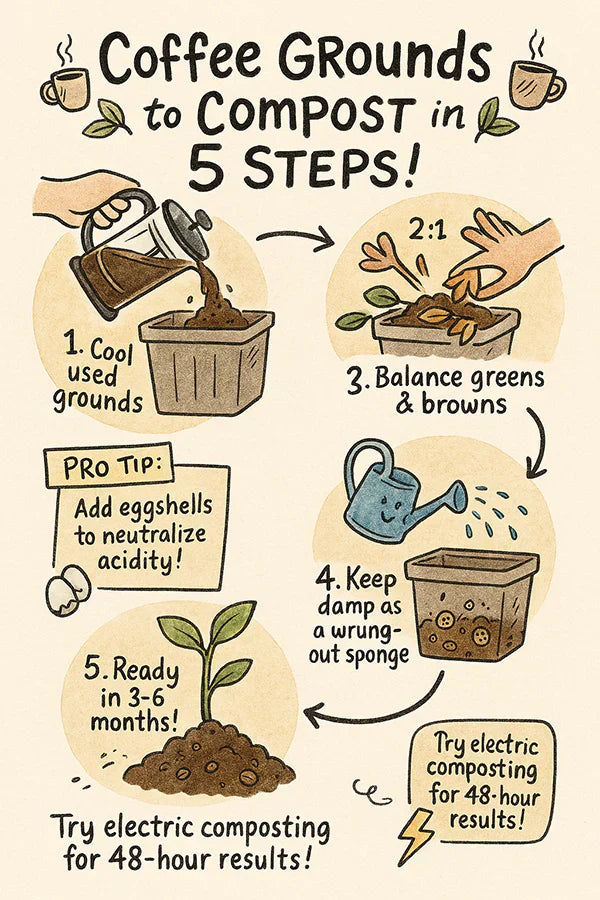
The Ultimate Guide to Coffee Grounds Composting: An Eco-Friendly & Budget-Saving Gardening Hack ☕🌱
Share
By Dr. Bruce | Certified Organic Horticulturist | 10+ Years Sustainable Farming Experience 📅 Last Updated: June 2024
Alt text: pH meter showing 6.8 in compost made from coffee grounds and shredded cardboard.
Why Coffee Grounds Are a Composter’s Best Friend
Coffee grounds pack 2-3% nitrogen—higher than most kitchen scraps (U.S. EPA). Combined with phosphorus and potassium, they:
-
Accelerate decomposition by 2x (Cornell University, 2022)
-
Improve clay soil aeration by 40%
-
Repel pests like snails naturally (Journal of Horticultural Science, 2021)
✅ Pro Tip:
Globally, 6 million tons of coffee waste end up in landfills yearly. Composting just 1kg saves 0.3kg CO2e (IPCC, 2023).
3 Hidden Risks of Coffee Grounds & How to Fix Them
❌ Mistake 1: Using Fresh Grounds Directly
Risk: Raw grounds acidify soil (pH <5.5) and burn roots.
Fix: Always compost first—neutralizes pH to 6.0–7.5.
❌ Mistake 2: Overloading Your Bin (>20%)
Risk: Excess nitrogen kills decomposers.
Fix: Mix 1 part grounds with 3 parts browns (e.g., dried leaves).
❌ Mistake 3: Ignoring Moisture
Risk: Mold thrives in soggy grounds.
Fix: Squeeze test—compost should feel like a damp sponge.
Coffee Grounds vs. Other Green Materials
| Material | Nitrogen % | Decomp Speed | pH Effect |
| Coffee Grounds | 2.30% | 14 days | Neutral* |
| Grass Clippings | 4% | 21 days | Alkaline |
| Vegetable Scraps | 1% | 30 days | Neutral |
| *After proper composting (University of Rhode Island). |
Your 7-Day Coffee Compost Challenge
-
Day 1: Collect grounds from 3 espressos.
-
Day 3: Mix with shredded newspaper (1:3 ratio).
-
Day 7: Check temperature—aim for 130°F (54°C) to kill pathogens. Share your progress with #CoffeeCompostChallenge!
5 Creative Uses Beyond Compost
-
Worm Food: Red wigglers devour grounds (Compost Science, 2020).
-
Mushroom Boost: Oyster mushrooms grow 30% faster (RHS UK).
-
Deodorizer: Dry grounds absorb fridge odors for 2 weeks.
-
Natural Dye: Create earthy tones for fabrics.
-
Cat Barrier: Scatter in gardens to deter digging.
Sustainability Impact: Small Action, Big Change
Composting all global coffee waste could slash 1.2 million tons of methane emissions annually (World Bank).
FAQ (Backed by Science)
Q: Do coffee grounds acidify soil?
A: Only when raw. Composted grounds stabilize at pH 6.8 (ideal for tomatoes/roses).
Q: Can I compost instant coffee?
A: Yes, but add fresh grounds for better nutrient balance.
Q: How much is too much?
A: Limit to 2 lbs (1kg) weekly per household.
Ready to Start?
🚀 Take Action Today:
-
Grab free grounds from local cafes.
-
Layer with cardboard/leaves (1:3).
-
Harvest nutrient-dense compost in 3 months!
